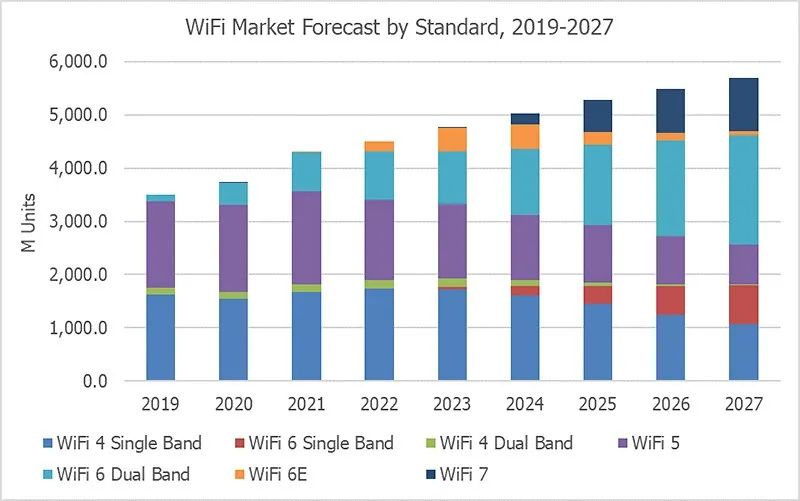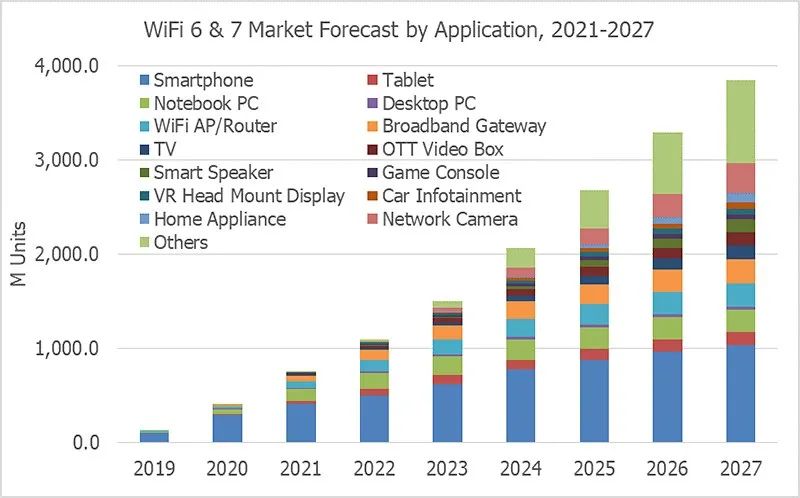The latest analysis of WiFi 6E and WiFi 7 market!

WiFi has been expanding its deployment and applications, from computers and networks to mobile, consumer and IoT-related devices. The WiFi industry developed the WiFi 6 standard to cover low-power IoT nodes and broadband applications, WiFi 6E and WiFi 7 added new 6GHz spectrum to meet higher bandwidth applications, such as 8k video and XR display, the added 6GHz spectrum also It is expected to realize high-reliability IIoT solutions by improving interference and latency.
This article will discuss the WiFi market and applications, with a particular focus on WiFi 6E and WiFi 7.
WiFi Market and Applications

After strong market growth in 2021, the WiFi market is expected to grow by 4.1% to approximately 4.5 billion connections by 2022. We forecast rapid growth through 2023-2027, reaching about 5.7 billion in 2027. Smart home, automotive and embedded IoT applications will significantly support the growth of WiFi device shipments.
The WiFi 6 market started in 2019 and is growing rapidly in 2020 and 2022. In 2022, WiFi 6 will account for about 24% of the entire WiFi market. By 2027, WiFi 6 and WiFi 7 together will account for about 2/3 of the WiFi market, and 6GHz WiFi 6E and WiFi 7 will grow from 4.1% in 2022 to 18.8% in 2027.
The 6GHz WiFi 6E will initially hit the US market in 2021, followed by the European market in 2022. WiFi 7 devices will begin shipping in 2023 and are expected to surpass WiFi 6E shipments by 2025.
6GHz WiFi has huge advantages in broadband, gaming, and video streaming applications, and it will also be an important application scenario in specific industrial IoT solutions that require high reliability and low latency communication, such as factory robot automation and AGV. 6GHz WiFi also improves the accuracy of WiFi positioning, allowing WiFi positioning to achieve more accurate positioning functions at long distances.
Challenges in the WiFi Market
There are two main challenges to 6GHz WiFi market deployment, spectrum availability and additional cost. 6GHz spectrum allocation policies vary by country, and under current policies, China and Russia do not allocate 6GHz spectrum for WiFi. China currently plans to use 6GHz for 5G, and China, the largest WiFi market, will therefore lack certain advantages for the future WiFi 7 market.
Another challenge with 6GHz WiFi is the additional cost of the RF front end (broadband PA, switches and filters). The new WiFi 7 chip module will add another cost to the digital baseband/MAC part to increase data throughput. Therefore, 6GHz WiFi will be mainly adopted in developed countries and high-end smart devices.
WiFi suppliers start shipping 2.4GHz single-band WiFi 6 chip modules in 2021, replacing traditional WiFi 4 that is widely used in IoT devices. New features such as TWT (Target Wake Time) and BSS color increase the benefits of IoT devices by adding lower power operation and better spectrum utilization. By 2027, 2.4GHz single-band WiFi 6 will have a 13% market share.

For applications, WiFi access points/routers/broadband gateways, high-end smartphones and PCs were the first to adopt WiFi 6 in 2019, and these are still the main applications of WiFi 6 so far. In 2022, smartphones, PCs and WiFi network devices will account for 84% of WiFi 6/6E shipments. During 2021-2022, more and more WiFi applications are turning to WiFi 6. Smart home devices such as smart TVs and smart speakers will start adopting WiFi 6 in 2021; home and industrial IoT applications, and cars will also adopt WiFi 6 in 2022.
WiFi networks, high-end smartphones and PCs are the main applications of WiFi 6E/WiFi 7. In addition, 8k TVs and VR headsets are also expected to be the main applications of 6GHz WiFi. By 2025, 6GHz WiFi 6E will be used in automotive infotainment and industrial automation.
Single-band WiFi 6 is expected to be used in low-data-speed WiFi applications such as home appliances, home IoT devices, webcams, smart wearables, and industrial automation.
Major Manufacturers of WiFi 6/7 Chip Modules
Qualcomm, Broadcom, and Intel were the first to bring WiFi 6 chip modules to market in 2019, followed by Infineon (Cypress), NXP, MediaTek, ON Semiconductor, MaxLinear (Intel), and Switzerland in 2020 Celeno. During 2021-2022, Synaptics, Realtek, Espressif and Beken also joined the track.
In 2021, Broadcom (smartphones, tablets, PCs, WiFi networks), Qualcomm (smartphones, tablets, PCs, WiFi networks) and Intel (for PCs) together account for more than 85% of the WiFi 6 chip market share. MediaTek, NXP, ON Semiconductor and other companies will also get a share of the "cake" in 2021. With more and more applications of WiFi 6, the market of WiFi 6 chips will become more diversified.
The WiFi 7 chip module has been announced in the second quarter of 2022, and the WiFi 7 Draft 2 (WiFi 7 Release 1) standard has also been released. Qualcomm, Broadcom and MediaTek are the first to release WiFi 7 chip modules, and Intel is expected to release WiFi 7 chip modules in early 2023.
In WiFi 7 chip modules, MediaTek and Broadcom (for mobile devices) use 6/7nm advanced semiconductor process nodes. Since 6/7nm IC design requires huge development costs, this is an obstacle for small and medium-sized semiconductor companies to develop high-end WiFi 7 chipsets in the future.
For single-band WiFi 6-chip modules, Espressif leads in production, followed by Beken and AIC Semiconductor. Domestic IC suppliers will give priority to using WiFi 6 chip modules in IoT WiFi chipsets.
Summarize
In the future, our way of life will be changed by the Internet of Things, which requires connectivity, and the continuous enhancement of WiFi has also provided great innovation for the connection of the Internet of Things. Judging from the current standard progress, WiFi 7 will greatly improve and enhance the application and experience of wireless terminals. At present, home users may not need to follow the trend to pursue WiFi 7 devices, which can be more valuable to industry users.